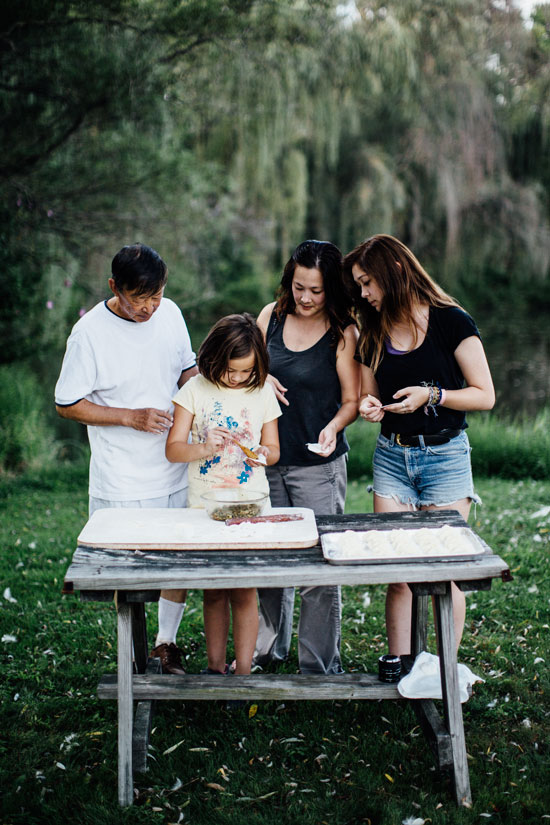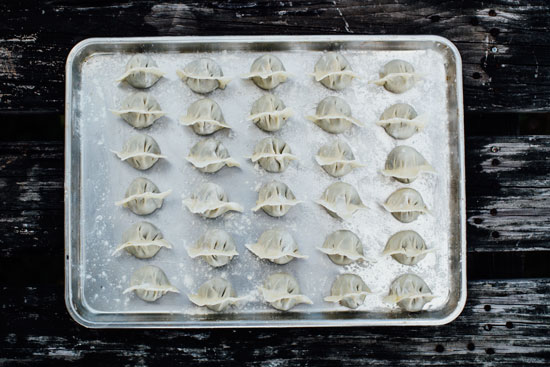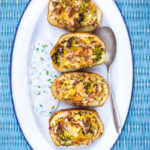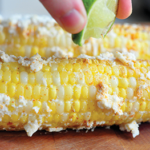Excerpted from Wendy Kiang-Spray’s The Chinese Kitchen Garden, on sale February 8!
Good Luck in the New Year
Chinese vegetables play a large, enchanting role in symbolic meals and traditions, especially around the Lunar New Year, which always falls near the end of winter and is the biggest celebration in Hong Kong, China, and much of Asia. Plants that symbolize fortune, such as kumquats (gum in Cantonese, a homophone for gold), are given as gifts or used to decorate the house. My parents make a big dinner full of symbolic foods, such as a fish (yue in Cantonese, a homophone for abundance). My father’s dumplings are particularly special as he hides coins in a few, bringing good luck in the upcoming year to whoever finds them. My favorite tradition is the Chinese lion dance—a beautiful and colorful martial art form with bright, ornate costumes and drumming so intense you can feel it in your heart. The performance culminates with someone feeding the lion a real head of cabbage (choy in Cantonese, a homophone for fortune). A long dramatic pause follows, punctuated by a soft clattering of the gongs, during which the lion is chewing. Then the cymbals clash loudly and the drums resume beating as the lion spits out the shredded cabbage, showering fortune on the people.

Photo © Sarah Culver
Hardy and Delicious Winter Vegetables
With a little protection from the elements, many vegetables will continue growing right through the coldest, snowiest days of winter. Under row covers or cold frames in the Chinese vegetable garden you may find hearty leafy greens (such as tatsoi and other cabbages), mustards, peas, turnips, kohlrabi, beets, and herbs (like chives or cilantro). A coating of frost on these frost-tolerant plants is usually not a problem. Leafy greens in particular may look wilted sometimes, but they will bounce back in warmer temperatures. Because the sun is lower in the sky and days are shorter, winter vegetables may not appear to be actively growing during the winter, but they are certainly alive and will be ready for harvest whenever you want them.

Photo © Sarah Culver
My father makes dumplings throughout the year, usually taking requests for the different filling combinations, both traditional and of his own creation. I am finally revealing a family secret with the recording of my father’s crab, pork, and Napa cabbage dumpling recipe. Because Napa cabbage is so mild in taste, its presence is barely noticeable, but the high water content of the cabbage contributes to the juiciness of these dumplings. You can purchase dumpling wrappers in Asian supermarkets.
Crab, Pork, and Napa Cabbage Dumplings
Print RecipeIngredients
- ⅓ cup finely chopped cilantro
- 1 pound Napa cabbage, chopped fine with excess water drained and squeezed out
- 3 spring onions, chopped very fine
- 1 inch ginger, minced
- ¼ pound crabmeat, picked through and chopped
- 1 pound ground pork, finely minced
- 1 tablespoon Shaoxing rice wine or brandy
- ¼ cup soy sauce
- 2 tablespoons corn or vegetable oil
- ¼ cup dark (toasted) sesame oil
- 2 teaspoons sweet bean sauce
- Pinch of sugar
- Pinch of salt
- Pinch of white pepper
- 1 (30-count or more) package of round white dumpling wrappers
- Soy sauce or black vinegar for serving
Instructions
Combine the cilantro, Napa cabbage, spring onions, ginger, crabmeat, ground pork, rice wine, soy sauce, corn oil, sesame oil, sweet bean sauce, sugar, salt, white pepper, and ½ cup of water in a large bowl. Stir vigorously for several minutes—this laborious step is the key to creating a filling with a light texture.
With a dumpling wrapper in the palm of one hand, place about a tablespoon of filling in the center of the wrapper. Bring the sides together, pleating as necessary and forming a little purse. Gently cup the filled center in your hands so it does not get crushed and squeeze the edges together tightly with both hands. Continue to fill all dumpling wrappers.
Fill a wok or deep pan with water to 2 inches below the top. Heat water to a rolling boil. Working in batches so the wok is not too crowded, drop dumplings in and continuously and gently stir until they float to the top. At this point, add ½–1 cup of cold water to bring the boil down. When water comes back up to a boil, add another ½–1 cup of water. This process allows dumplings to cook gently without breaking. When the water comes back up to a boil again, dumplings should be another minute or so away from being ready.
Test for doneness by pressing into the dumpling. The filling inside should feel firm and be very juicy but cooked through and hot. Serve with a little soy sauce or black vinegar.
 About the Book:
About the Book:
A beautiful introduction to growing and cooking with the variety, deliciousness, and healthfulness of Chinese cuisine!
Wendy Kiang-Spray’s family has a strong culinary and gardening tradition. In The Chinese Kitchen Garden, she beautifully blends the story of her family’s cultural heritage with growing information for 38 Chinese vegetables—like lotus root, garlic, chives, and eggplant—and 25 traditional recipes, like congee, dumplings, and bok choy stir-fry. Organized by season, you’ll learn what to grow in spring and what to cook in winter.
Buy the Book
Amazon | B&N | Indiebound | Workman





No Comments